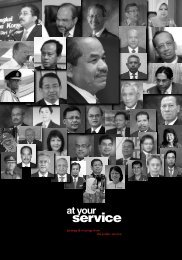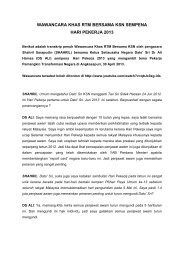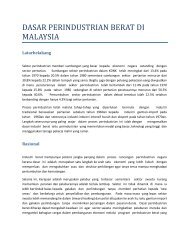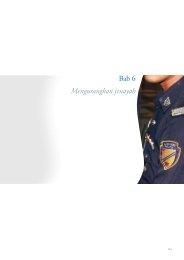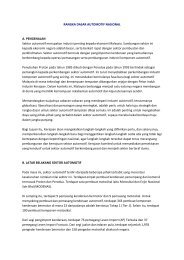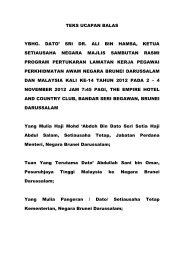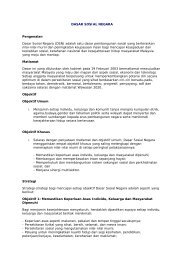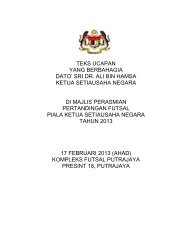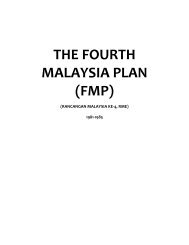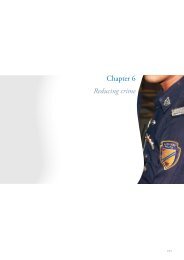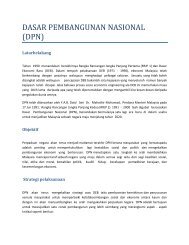GTP 2.0 - Prime Minister's Office of Malaysia
GTP 2.0 - Prime Minister's Office of Malaysia
GTP 2.0 - Prime Minister's Office of Malaysia
You also want an ePaper? Increase the reach of your titles
YUMPU automatically turns print PDFs into web optimized ePapers that Google loves.
INtEGRatIoN<br />
The UPT NKRA recognises that the change to<br />
best public transport systems are integrated,<br />
meaning that there are cohesive and simple<br />
transfers between different modes <strong>of</strong> public<br />
transport. This means that commuters should<br />
be able to transfer from train lines to inter- and<br />
intra-city buses seamlessly when undertaking<br />
their journey.<br />
<strong>GTP</strong> 1.0 has made a number <strong>of</strong> changes to<br />
facilitate better integration, the most notable<br />
being the introduction <strong>of</strong> the Integrated<br />
Transport Terminal in Bandar Tasik Selatan, which<br />
integrates south-bound intra-city travel with<br />
the KTM Komuter, LRT and ERL. The refurbished<br />
Puduraya Bus Terminal performs the same<br />
function but caters to north-bound traffic.<br />
There are also plans underway to better<br />
integrate the two main LRT lines–the Kelana<br />
Jaya and Ampang lines–at three stations: Hang<br />
Tuah, Masjid Jamek and Titiwangsa. The goal<br />
is to create common concourses facilitating<br />
seamless transfers between both lines. Presently,<br />
commuters need to exit the turnstiles from each<br />
respective line before transferring over to the<br />
other, which further adds to commute times.<br />
The launch <strong>of</strong> the Pasar Seni Bus Hub in<br />
August 2012 also represented the first <strong>of</strong> several<br />
city bus hubs planned to improve integration<br />
between road and rail service. Similar facilities<br />
have been planned for five other corridors<br />
within the city centre, and are expected to ease<br />
traffic congestion and further encourage public<br />
transport usage.<br />
Supporting infrastructure such as parking<br />
complexes near rail<br />
stations–also known<br />
as Park & Rides–are<br />
also being developed<br />
along side some <strong>of</strong><br />
the busiest locations,<br />
such as in Sungai Besi<br />
and Gombak.<br />
NEtWoRk ENhaNCEmENt<br />
The goal <strong>of</strong> initiatives under<br />
this workstream is to further<br />
enhance and tweak the network<br />
infrastructure <strong>of</strong> all modes <strong>of</strong> public<br />
transport to make it more attractive<br />
to commuters. For example, the<br />
introduction <strong>of</strong> information boards<br />
providing estimated arrival times<br />
using GPS systems for buses in<br />
selective bus stops make bus<br />
travel a more reliable form <strong>of</strong><br />
public transport.<br />
As the UPT NKRA has mainly<br />
focused on increasing capacity<br />
in <strong>GTP</strong> 1.0, the rakyat can expect<br />
to see more innovations in this<br />
workstream over the next three<br />
years.<br />
Proposed<br />
key functions<br />
1 Serve as collaboration platform for<br />
new UPT enforcement-related<br />
initiatives.<br />
2 Improve eiciency <strong>of</strong> UPT<br />
enforcement processes<br />
(e.g., IP processing, cross-agency<br />
processes and etc.).<br />
3 Serve as UPT enforcement<br />
information sharing hub where it<br />
can serve as intelligence for future<br />
operations.<br />
4 Support new bus and taxi<br />
initiatives <strong>of</strong> the <strong>GTP</strong> <strong>2.0</strong> UPT lab.<br />
(For example, enforcement <strong>of</strong> bus<br />
lanes where JPJ and PDRM are<br />
involved in enforcement <strong>of</strong> private<br />
vehicles.)<br />
ENablERs<br />
In addition to the initiatives above, the UPT NKRA has also identified a<br />
number <strong>of</strong> ‘Enablers’ that will help to achieve its target modal share. The<br />
enabling projects are:<br />
Fare review<br />
Fares will be reviewed to ensure they are commercially sustainable<br />
and that operators as well as routes will not be abandoned if found<br />
to be unpr<strong>of</strong>itable.<br />
driver’s academy and Enhancement Programme<br />
A lack <strong>of</strong> qualified bus drivers continues to be a significant issue for<br />
urban public transport, and the development <strong>of</strong> a training academy will<br />
help to solve this issue.<br />
Joint Task Force for enforcement<br />
Enforcement <strong>of</strong> the various facets <strong>of</strong> UPT remains a key issue as at<br />
least six regulatory agencies overlook UPT. The creation <strong>of</strong> a joint task<br />
force will help streamline the enforcement process ensuring greater<br />
efficiencies.<br />
STRUCTURE OF THE<br />
JOINT TASK FORCE FOR ENFORCEMENT<br />
NKRA<br />
Delivery<br />
Task Force<br />
UPT Joint<br />
Task Force<br />
for Enforcement<br />
• Chaired by YAB DPM<br />
• Members include Lead Minister,<br />
Participating Ministers and KSUs<br />
• Chairman: Head <strong>of</strong> SPAD Enforcement<br />
• Director <strong>of</strong> Enforcement, JPJ<br />
• Secretariat Enforcement SPAD<br />
SPAD PDRM<br />
JPJ DBKL<br />
Frequency Once a month<br />
Attorney General’s<br />
Chambers<br />
174 Government transformation Programme—Annual Report 2012 Chapter Nine 175<br />
Government transformation Programme—Annual Report 2012 Chapter Nine




